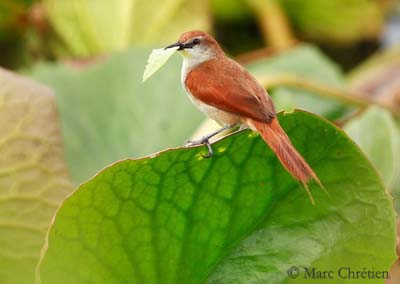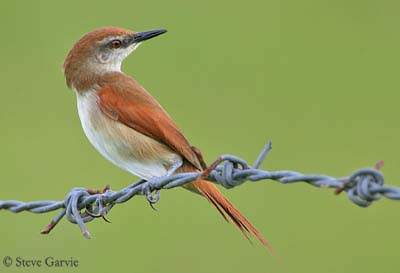
Yellow-chinned Spinetail
Certhiaxis cinnamomea
Passeriforme Order – Furnariidae Family
BIOMETRICS:
Length: 13 à 16 cm
Weight: 13 à 17 g
DESCRIPTION:
Yellow-chinned Spinetail belongs to the Furnariidae family, but instead to build a clay nest as the Rufous Hornero, this species builds a bulky spherical nest with sticks.
Adult male has reddish upperparts. Mantle is rather reddish-brown, whereas the rump is paler rufous-brown. Upper wing is bright rufous, but the flight feathers show dusky tips. Uppertail coverts are darker and more reddish. The long tail is graduated and has “spiny” appearance, due to the particular shape of the feathers. The tail is mostly rufous, but the central pair of rectrices shows brownish inner webs.
PROTECTION / THREATS / STATUS:
Yellow-chinned Spinetail is common and relatively abundant in most parts of its range. Drainage and restriction of wetlands may threaten the species living in humid areas.
Fr: Synallaxe à gorge jaune
All : Gelbkinn-Riedschlüpfer
Esp : Curutié Colorado
Ital : Codaspinosa color cannella
Nd : Geelkeel-stekelstaart
Photographs by Patrick Ingremeau
His website : TAMANDUA
Photographs by Steve Garvie
His website : RAINBIRDER Photo galleries
Photograph by Marc Chrétien
His website : MURINUS
Text by Nicole Bouglouan
Sources:
HANDBOOK OF THE BIRDS OF THE WORLD Vol 8 By Josep del Hoyo-Andrew Elliott-David Christie - Lynx Edicions - ISBN: 8487334504
A GUIDE TO THE BIRDS OF COLOMBIA by Steven L. Hilty and William L. Brown - Princeton University Press – ISBN 069108372X
Birds in Suriname, South America (Jan Hein Ribot)
Wikipedia (Wikipedia, The Free Encyclopedia)

Underparts are paler, rather whitish. The chin and the upper throat are yellow, giving this species its name. Lower throat is white. Breast and belly are creamy-white with pale grey-brown body sides. Flanks and undertail coverts are pale buffy-brown. Undertail feathers are darker, mostly rufous.
On the head, the crown is reddish-brown, and nape is slightly paler joining the back. We can see grey supercilium, and broad blackish eyeline. Face is pale greyish. Bill is blackish. Eyes are reddish-brown to pale orange, but some variations to whitish are possible. Legs and feet are bluish-grey.
Both sexes are similar.
Juvenile lacks the yellow chin.
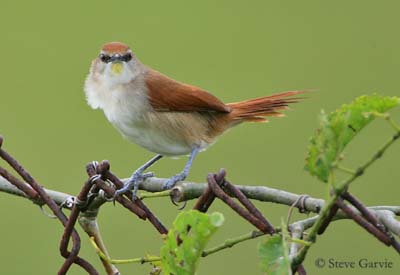
Yellow-chinned Spinetail has 8 subspecies:
Certhiaxis cinnamomea cinnamomea;
C.c. fuscifrons, with dusky brown forehead;
C.c. marabinus, with the most reddish upperparts, dusky greyish forehead and whiter supercilium;
C.c. valencianus has less reddish upperparts and darker underparts;
C.c. orenocensis is the palest and the dullest of any races. It has sandy-brown back and dusky spot on the terminal part of the inner webs of central rectrices;
C.c. pallidus, similar to previous with brighter upperparts;
C.c. cearensis is brighter overall with darker flanks;
C.c. russeolus has browner upperparts, and mostly greyish flanks and undertail coverts.
VOICE: SOUNDS BY XENO-CANTO
Yellow-chinned Spinetail’s call is a sharp “chip”. We can also hear a sharp whirring rattle rising and then, fading to the end “chu-chuchchchchch…” often uttered as duet. This bird also utters short, thin, buzzy trill.
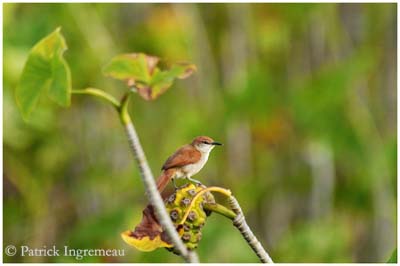
HABITAT:
Yellow-chinned Spinetail is common in humid areas such as marshes, mangroves borders, grassy and shrubby wetlands with vegetation, both emergent and floating. It is found from sea-level to 500-750 metres of elevation.
RANGE:
Yellow-chinned Spinetail is resident in its range from Trinidad and Colombia, southwards to Argentina and Uruguay.
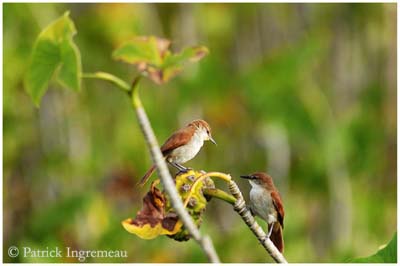
BEHAVIOUR:
Yellow-chinned Spinetail feeds mainly on varied insects found between the grass stalks. It usually forages alone or in pairs. Arthropods are taken from small branches and foliage, but sometimes from the ground or even water.
It is active by day, and often adopts acrobatic postures when perched.
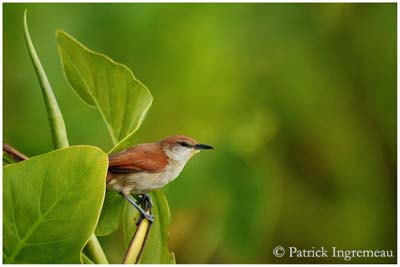
It is probably territorial all year round, living in a relatively small territory.
Yellow-chinned Spinetail is resident in its range.
The behaviour of this species is poorly known at this moment.
FLIGHT:
Yellow-chinned Spinetail usually flies very short distances at time.
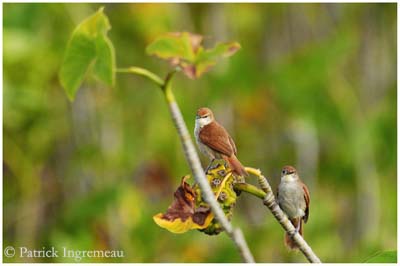
REPRODUCTION:
Breeding season varies according to the range.
Yellow-chinned Spinetail builds a bulky, spherical nest of 25 to 40 cm length, and 20 to 30 cm high. This nest is often situated in low vegetation, in bush or grass, and near or over the water. Height may vary from 0, 20 to 1, 5 metres, sometimes up to 9 metres above the ground. When the nest is built in mangroves it is usually placed between roots.
Yellow-chinned Spinetail does not reuse the same nest, and builds other structure sometimes placed above the old one.
The nest is made with interwoven sticks, sometimes thorny sticks. There is a tunnel-shaped entrance of about 20 to 25 cm length to the nest-chamber. The incubating-chamber is about 10 cm in diameter, and sometimes lined with fine vegetation.
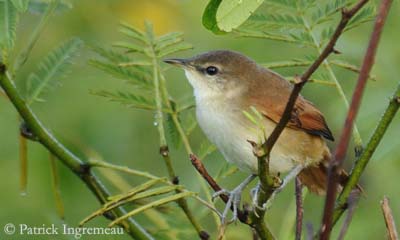
Female lays 2 to 5 greenish-white eggs. Incubation lasts between 14 to 22 days, usually two weeks. Both parents incubate and take turns at nest.
Chicks are altricial and fledge about 13 to 18 days after hatching. The young are able to defend themselves, producing hissing noises as snakes, and striking out.
Young are fed by both adults once or twice per hour, and remain with parents for some weeks more.
Yellow-chinned Spinetail’s nest is often parasitized by Striped Cuckoo (Tapera naevia).
DIET:
Yellow-chinned Spinetail feeds mainly on insects and larvae, and also spiders.
